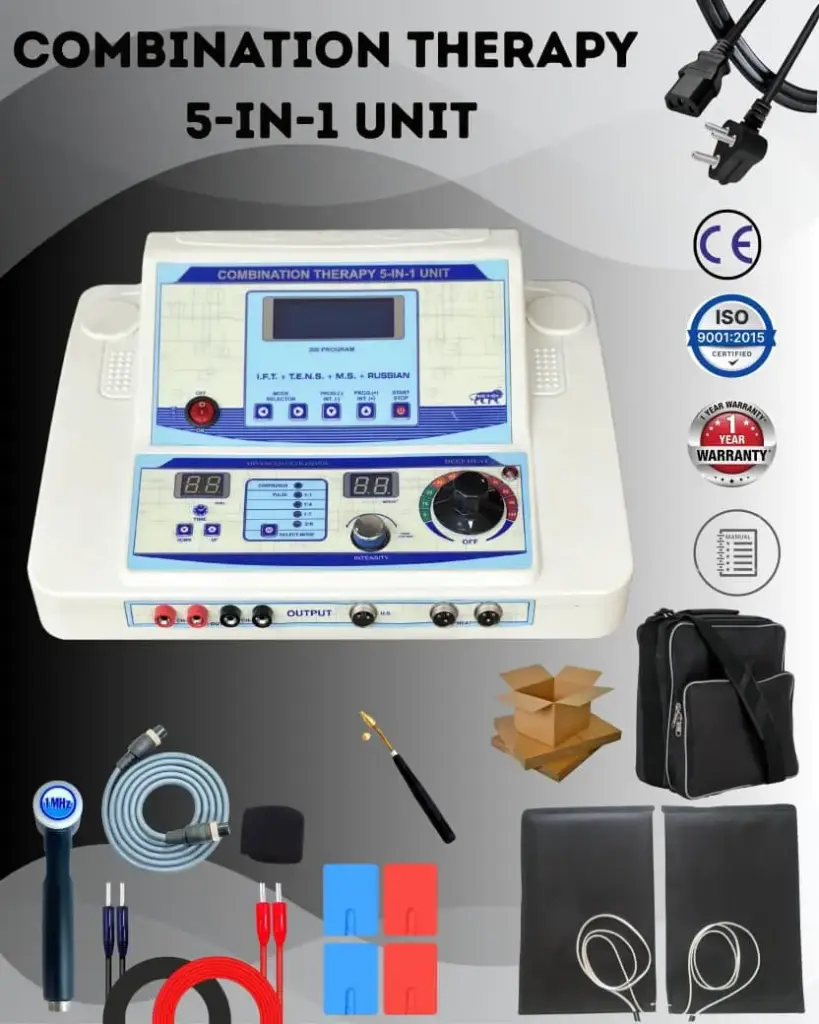Combination Therapy 5-in-1 Unit — Mode Details
This section provides clear, professional descriptions for each therapy mode included in the Combination Therapy 5-in-1 Unit: IFT, TENS, MS, Russian Current, and Ultrasound (US). Use these blocks individually on product pages or combine them as needed.
1. IFT (Interferential Therapy)
Overview: Interferential Therapy (IFT) uses two medium-frequency currents that intersect in the tissue to create a low-frequency therapeutic effect deep in muscles and joints.
- How it works: Two slightly different medium-frequency currents cross and produce an interference current at the target depth, delivering effective deep heating and pain modulation.
- Key benefits: Deep pain relief, reduced swelling, improved local circulation, and muscle relaxation.
- Typical applications: Chronic musculoskeletal pain, low back pain, knee pain, shoulder pain, post-traumatic edema, and soft-tissue injuries.
- Typical settings/notes: Use comfortable intensity that reduces pain without causing discomfort; treatment duration commonly 10–20 minutes depending on condition.
2. TENS (Transcutaneous Electrical Nerve Stimulation)
Overview: TENS delivers low-voltage electrical pulses through skin electrodes to modulate pain signals and provide symptomatic pain relief.
- How it works: Electrical pulses stimulate large-diameter sensory fibres and activate inhibitory pathways, reducing pain signal transmission to the brain.
- Key benefits: Immediate pain relief, non-invasive, drug-free pain management suitable for acute and chronic pain.
- Typical applications: Sciatica, neuralgia, postoperative pain, musculoskeletal pain, and localized chronic pain conditions.
- Typical settings/notes: Use frequency and pulse width appropriate to the pain type (high frequency for sensory pain relief; low frequency for endogenous opioid release). Session length usually 20–40 minutes as tolerated.
3. MS (Muscle Stimulator)
Overview: Muscle Stimulator (MS) produces electrical pulses that cause rhythmic muscle contractions to strengthen, retrain, and prevent atrophy of targeted muscles.
- How it works: Low-frequency, controlled pulses activate motor nerves causing visible muscle contraction and relaxation cycles aiding re-education and strengthening.
- Key benefits: Improves muscle strength, prevents disuse atrophy, supports neuromuscular re-education, and enhances local circulation.
- Typical applications: Muscle weakness after injury or surgery, hemiplegia/paresis rehabilitation, post-fracture recovery, and sports conditioning.
- Typical settings/notes: Gradually increase intensity to elicit comfortable contractions; typical duty cycle and on/off times vary by protocol (e.g., 10–15 minutes per muscle group).
4. Russian Current Therapy
Overview: Russian Current is a medium-frequency stimulation protocol designed for powerful, deep muscle contractions used primarily for strength training and re-education.
- How it works: A medium-frequency carrier (typically ~2,500 Hz) is amplitude-modulated to produce bursts that create strong but tolerable muscle contractions.
- Key benefits: High-intensity muscle strengthening, improved muscle tone, enhanced power generation and functional performance.
- Typical applications: Sports rehabilitation, muscle re-education, prehabilitation/conditioning, and post-surgical strengthening.
- Typical settings/notes: Applied with caution in rehabilitative settings—start with lower intensity and shorter burst durations, progressively increasing per patient tolerance and clinical goals.
5. Ultrasound Therapy (US)
Overview: Therapeutic ultrasound uses high-frequency sound waves (commonly 1 MHz or 3 MHz) to deliver mechanical and thermal effects within soft tissues.
- How it works: Ultrasonic waves produce micro-vibrations and controlled heat in tissues, promoting cellular repair, reducing stiffness, and increasing blood flow.
- Key benefits: Accelerates tissue healing, reduces pain and stiffness, promotes collagen extensibility, and decreases local inflammation.
- Typical applications: Tendonitis, ligament injuries, muscle strains, joint stiffness, bursitis, and post-surgical soft tissue healing.
- Typical settings/notes: 1 MHz for deeper tissues (up to ~5 cm), 3 MHz for superficial tissues; use coupling gel, move applicator continuously, typical treatment 5–10 minutes per area depending on size and protocol.
Important: Therapy parameters (intensity, frequency, duty cycle, duration) must be set by a qualified clinician based on patient condition and tolerance. Always follow device manufacturer guidelines and clinical protocols.
Descriptions provided are intended for use in product listings and clinician reference. For clinical use, refer to official user manuals and follow local regulations.





